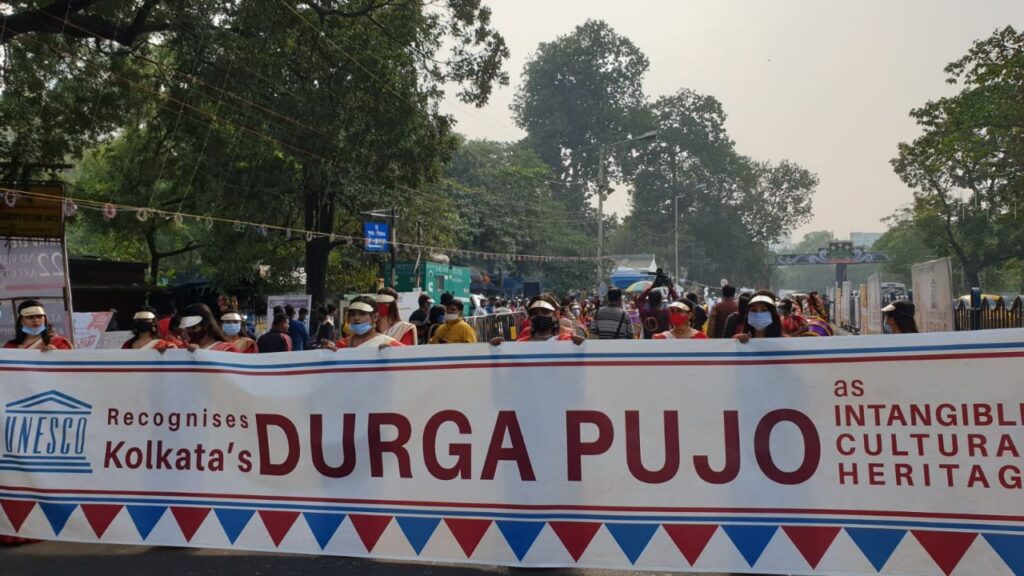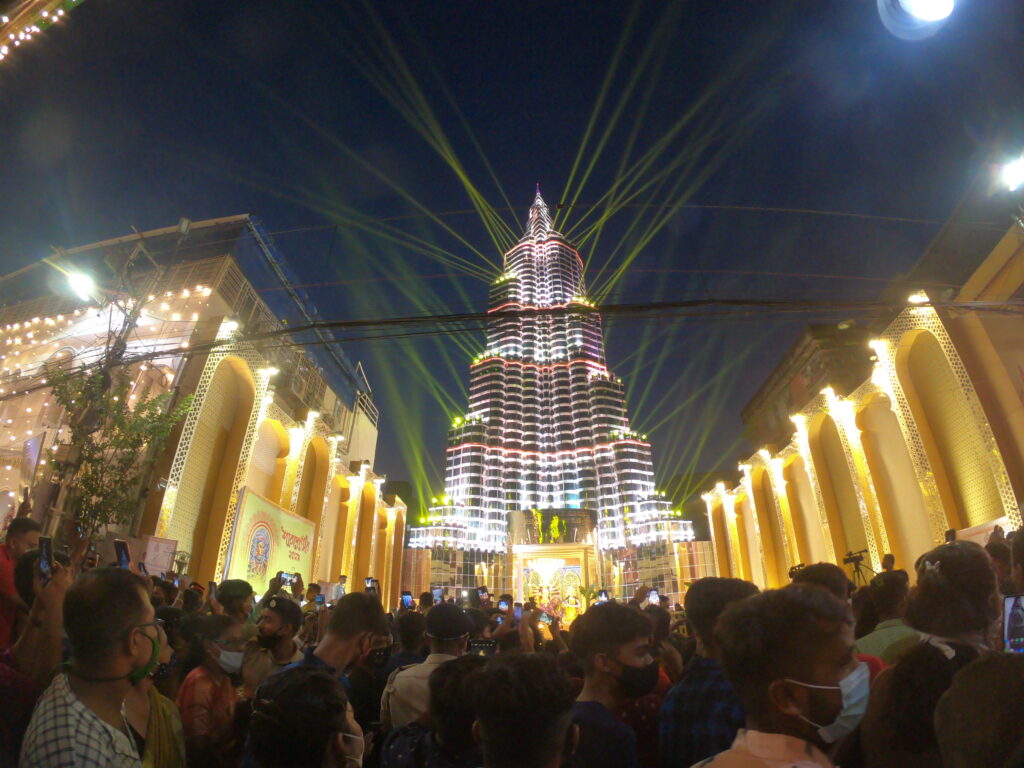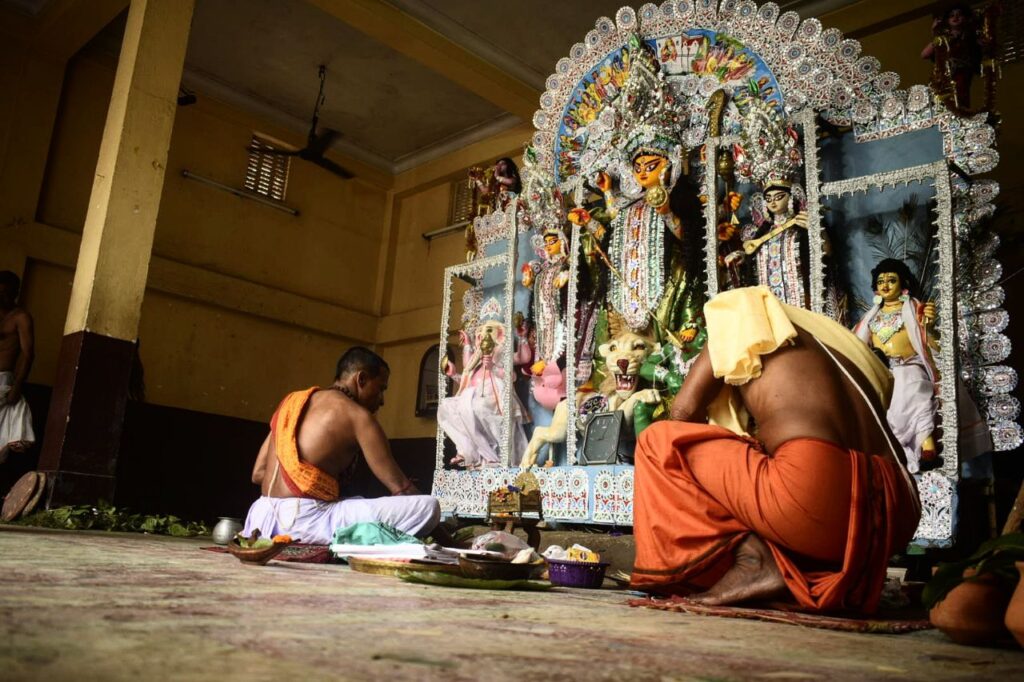Two months after the end of the Durga Puja, Bengal is celebrating again. The festival that defines its culture has been marked by UNESCO as an ‘Intangible Cultural Heritage of Humanity’. It now proudly finds a place in the prestigious list.
In Bengal, time freezes around the Durga Pujo time. The rituals, prayer, festivities – all the scenes that mark the festival – remain more or less the same as they were ages ago. The scene in 2020 and 2021, however, was different. COVID-19 kept several people indoors and the Pujo spirit remained subdued.
But the December 21 UNESCO announcement brought back the festive fervor in all its might, stretching the gaiety of the festival beyond its usual five-day annual schedule.

The people lapped up the news with joy and pride, and rejoiced in all ways they could. The lovers of Pujo in Kolkata (also part of the association ‘Kolkatar Pujo Premi’, which includes installation artists, puja organisers, sculptors, painters, etc.) took out a rally from the Academy of Fine Arts to Esplanade to celebrate what they feel is an acknowledgement that took a long time to come.
“In our country, we don’t appreciate what we have as long as it is not lauded in a foreign land. I think that this listing by UNESCO should have come earlier,” Susanta Paul, an installation artist, sculptor, and costume designer attached to the Pujo industry, says.
To Sushanta Paul, what makes the festival creative and distinct is the freedom it gives the artists to breathe life into their thoughts. “The Puja organisers invest in us without knowing the outcome. That is the creative liberty we get. And now, with the UNESCO listing, we have enough potential to make this festival a global phenomenon. In the late ’90s, when we started it was a very tough job, but now students passing out of art colleges have a whole platform created by us to showcase their talents. Overall, I feel that this will induce more interest in people and help artists both big and small.”

Even in suburbs and towns all over Bengal, the reaction of artists, members of bonedi bari units, and organising clubs are all ecstatic. The acknowledgment is being seen as a huge step to boost artists’ and people’s livelihood.
Kushal Bhattacharya, an artist and writer from Srirampore in Hoogly district feels the UNESCO acknowledgement will add to the tourism potential of the festival. “Durga Puja is celebrated most notably in Kolkata and greater Bengal as well as in other parts of India and among the Bengali diaspora. As such it attracts tourists from across the world. It also is an occasion of homecoming for Bengalis spread across the country and the globe. UNESCO’s intangible heritage mark is sure to bring in more tourist footfalls in the coming years,” he says.
For some like Subha Prasad Chatterjee who oversees a 500-year-old festival held annually in the ancestral house of the 19th century social reformer Raja Ram Mohan Roy (Roy’s Mamarbari), the UNESCO tag is more of a responsibility than an accolade.
Sitting in his house at Srirampore that bears proud marks of its antiquity, Mr. Bhattacharjee says, “the Puja at our home, better known as Guru Bari, is centuries old and was begun by our ancestors. As a member of a bonedi bari, I feel that the listing by UNESCO is a call for the age-old families across Bengal to work hard and preserve the traditions and rituals associated with the festival.”

A student of Class 9 at HM Education Centre School, Tannishee Bhattacharyya, feels giving Durga Puja a UNESCO tag is the best way to promote the State’s cultural integrity and social values. “All the year round we wait for the arrival of the season. Durga Puja is a way of celebrating our togetherness. It binds us as a society irrespective of religion and caste. The UNESCO acknowledgement will certainly help us gain international exposure,” she says.
Durga Puja committee members, who were in a great mood to celebrate, felt the UNESCO accolade is a shot in the arm for Bengali culture. Arnapratim Sarkar, a member of Haridevpur Vivekananda Park Athletic Club, feels Bengalis have again proved that their ‘madness’ can turn many a head. “UNESCO needs to be thanked for their gesture,” he says.
Edited by: Aparna Nair

